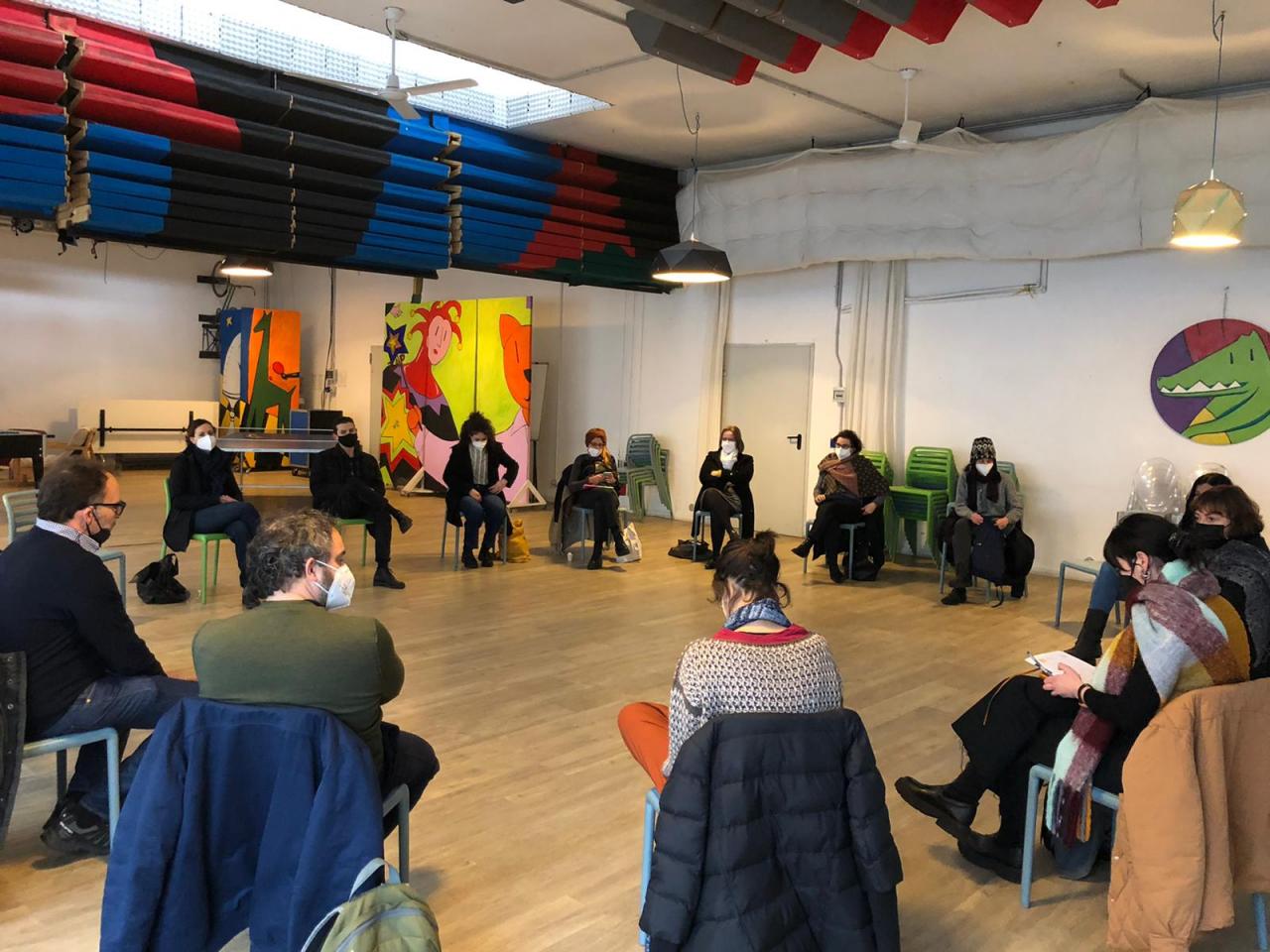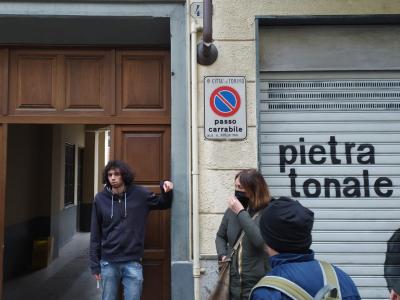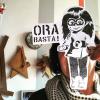
The fourth meeting of ULG Turin took place on 18 february 2022 at Hub Culturale - via Baltea.
The meeting focused on the story of CasaBottega from a double perspective. The Municipality perspective, in the person of Fabrizio Barbiero (City of Turin - Innovation and european funding office) and the territorial district one that oversaw the implementation of the process and relations with the neighborhood, in the person of Anna Rowinski (SuMisura Aps/ via Baltea Community Hub). The purpose of the meeting was to make the group know the governance models, the administrative tools and the community of reference identified.
CasaBottega project: urban regeneration actions in Barriera di Milano neighborhood
CasaBottega is a project by Sumisura APS with the public and private partnership: Liberitutti scs (Neighborhood House - Bagni Pubblici di via Agliè), Respons/Ability (Spazio Montanaro) Association, City of Turin - Youth and Services Decentralization Division - Creative Turin - District 6 and supported by Compagnia di San Paolo Foundation whiting the CivICa Call - Culture and Civic Innovation Projects
With the aim to strengthen the urban pattern of proximity, in particolar of the vulnerable neighborhood such as Barriera di Milano, CasaBottega was born as an experimentation of the urban regeneration actions through the re-functionalization of ground floors and some apartments by young artists. Seven closed spaces today host artistic workshops, cultural activities, residence and workplaces contributing to the improvement of the neighborhood in terms of livability.
When the innovation enter in the public policies - Fabrizio Barbiero
The project started with the awareness of the increase in vacant commercial spaces in the neighborhood and the consequent depletion of sociality in terms of economic and relational liveliness. However, the ground floors desertification cannot be countered with the tradizional tools which didn't bring visible improvements or reversals of the dynamics. In reverse, rethinking the spaces re-funcionalitation through creative and innovative solutions - in line with UIA fundamentals - in which direct involvement of the community take place at the all steps of the policy, it has made it possible to define a shared process that acts at the same time on several and interrelated issues, favoring new forms of active citizenship.
CasaBottega is a system of creative and plural places in which the themes of living, accessibility, youth work, coexistence and social cohesion come together and act to satisfy a real need and return a project with a high public vocation.
Synergistic work and the starting conditions
The dialogue with the Urban Planning office allowed to materialize the idea and to nominate the proposal to the Compagnia di San Paolo Foundation which recognized the civic and social value of CasaBottega and submitted it to funding.
The new element that has encouraged the process is the Simplification Degree n.120/2020 (without forgetting the reception at the municipal level which has defined its operational characteristics) which has permise the temporary uses of private spaces without the need to change their intended use. This element has supported the process, but should be noted that it is the set of factors, internal and external to the contest, to determine the success of the project. The essential factors are recognized in four key elements:

From the point of view of economic sustainability, the project was affected by two lines of financing. The Compagnia di San Paolo Foundation has given funding to the development of the policy in terms of planning, marketing and communication, while the Municipality of Turin donated a small non-repayable amount for direct support of businesses. Economic support means the possibility of getting involved and entering the business world, resulting in the reopening of 7 spaces which have affected the perception of the safety of the neighborhood and the ability to attract a wider community.
7 spaces recovered, 39 intercepted artists and the cultural activities - Anna Rowinski
Thanks to the CasaBottega project, today Barriera di Milano hosts 7 new cultural spaces in which 39 people work, with an average age of 27. The 7 youth businesses reopen their shutters daily, creating hybrid spaces that change shape, expanding towards the street or attracting people to the inner courtyards of the buildings. The translation from policy to practice was possible thanks to the constant dialogue between the network of partners, from a regulatory point of view as much as that of accompaniment and mediation. The call for the selection of artists saw significant participation, reaching 25 proposals from more or less constituted groups or individuals in different cultural and artistic fields. As with any scalable and implementable process, it is now possible to define the strengths and weaknesses of CasaBottega.

The strengths and weaknesses of CasaBottega
Among the strengths there is the definition of an intersectoral partnership in which institutional actors and territorial principals rooted in Barriera di Milano were present. Municipality, District, Neighborhood House and associations have worked synergistically by transmitting information from the bottom up and vice versa. The dialogue and collaborative approach made it possible to overcome obstacles and uncertainties by allowing mediation between the interests of the public and private parties. Another strong point is the target audience of the selection call. The choice to intercept young artists shows the desire to open spaces to new energies and contaminations with the aim of understanding space with respect to the relationships that insist on it. The young people selected took part in the competition aware of having a personal opportunity but, at the same time, of wanting to participate in social and collective life by giving back spaces that are open to the neighborhood and not closed in on themselves. This emerges in their ability to reinvent, in the midst of the pandemic, the activities following the intercepted needs, getting to know each other in the first phase and collaborating with each other and with via Baltea in the months of the lockdown through a collaborative and flexible approach.
In order to describe the critical issues, one of the main difficulties was finding spaces in the neighborhood suitable for the project and with owners willing to participate, which is why only some businesses have combined home and work. The dialogue with the public offices of private construction also determined some critical issues relating to the initial difficulty of understanding the potential of CasaBottega and taking the responsibility and expressing opinions on compliance with health and hygiene regulations and on the compatibility of two different functions (residence and commerce) within a single space. However, the structuring of a flexible, innovative and multi-stakeholder process has made it possible to create a non-competitive climate capable of being the trigger for new forms of local development.
Concluding collective reflections: the micro dimension and the value of co-design
With the premise that the pandemic emergency has certainly characterized the process in terms of adaptability, flexibility and generativity, the debate focused on three fundamental axes:
APPROACH: The establishment of an open community was possible thanks to the establishment of a collaborative environment which made it possible to transmit information effectively. The participants appreciated the collaboration with the municipality, recognizing it as a guarantee. At the same time, the management of the call by a more flexible actor than the public administration has made it possible to hook up diversified actors, formal or informal, who have found via Baltea a welcoming, inclusive place where they can bring their requests and build planning. The approach built for CasaBottega and the hybridization of spaces and functions showcases the ability of the public machine to learn from virtuous processes in favor of the dimension of dialogue and the micro scale of intervention where it is possible to find the links and relationships between subject and space.
TOOLS: The tools used during the process are traditional tools. Each group signed a lease agreement for the occupied spaces with a time limit of use and used the non-repayable sum to start the business. The sum had a significant impact on the departure if we consider the young age of the artists and the relative and potential economic instability.
The property owners, on the other hand, had a path of support and dialogue with via Baltea and with the Compagnia San Paolo Foundation which favored the control of any speculation on the initiative and the assessment of interest in the process for possible scalability.
SUSTAINABILITY: With the desire to countervert the present urban dynamics that see Barriera di Milano increasingly a dormitory area in which commercial desertification and perception of security limit the presence of territorial structures, CasaBottega presents itself as a multi-actor and intersectoral project capable of combining several aspects of urban life in a synergistic way. Until now, there are three organizations that, after participating in the call, have decided to join the association by working in terms of future visions and intentions. This is a key factor in setting complex, long-lasting processes that rekindle pieces of the city. In fact, the added value is their social predisposition, a legacy of the process in which they were involved. We need to protect this newborn experience to ensure that every single atelier takes root in the neighborhood, triggering other cascading processes.

